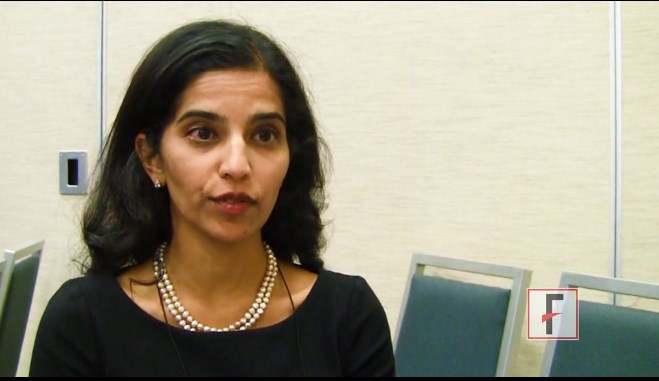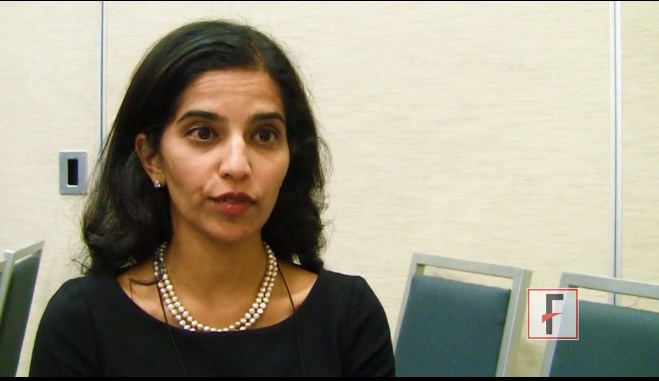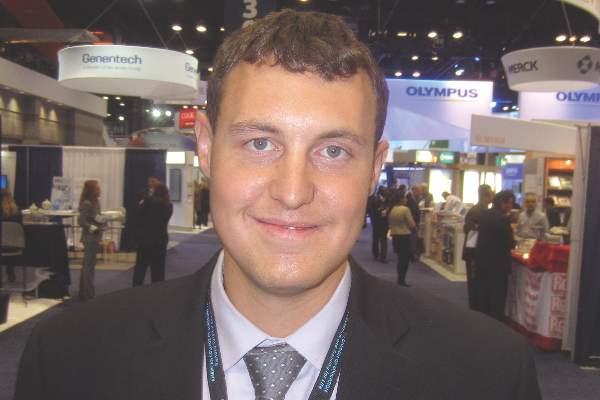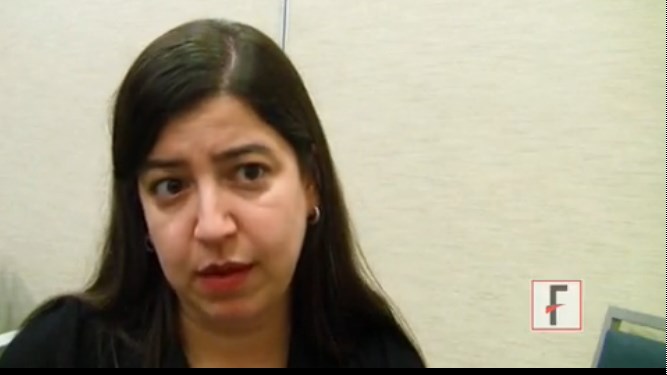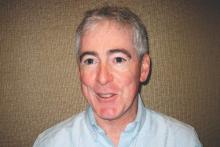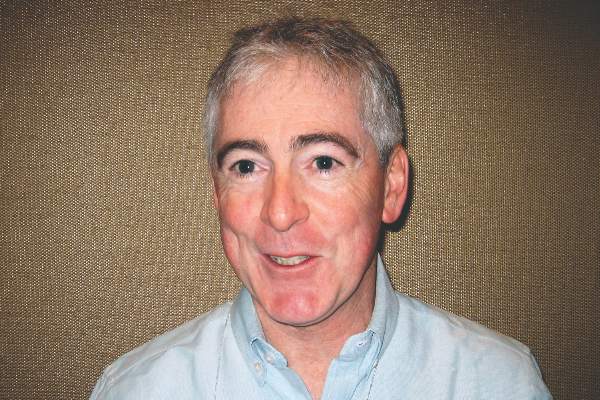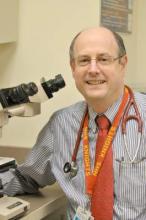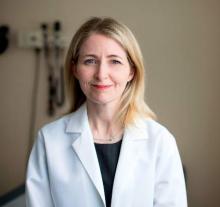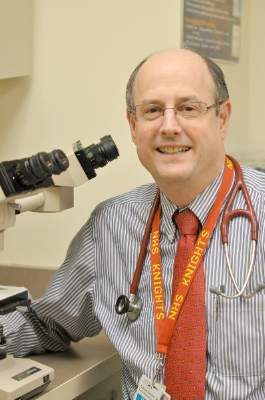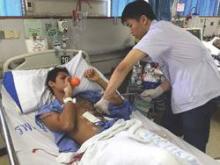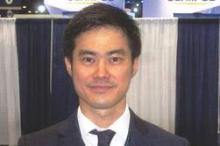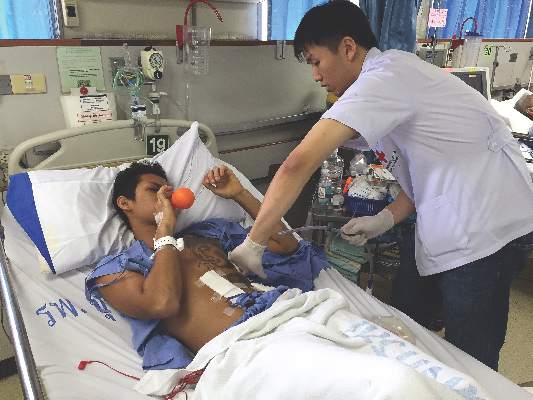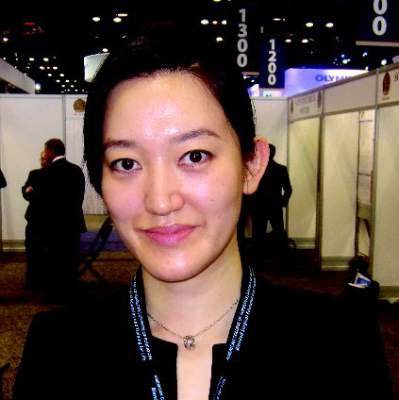User login
M. Alexander Otto began his reporting career early in 1999 covering the pharmaceutical industry for a national pharmacists' magazine and freelancing for the Washington Post and other newspapers. He then joined BNA, now part of Bloomberg News, covering health law and the protection of people and animals in medical research. Alex next worked for the McClatchy Company. Based on his work, Alex won a year-long Knight Science Journalism Fellowship to MIT in 2008-2009. He joined the company shortly thereafter. Alex has a newspaper journalism degree from Syracuse (N.Y.) University and a master's degree in medical science -- a physician assistant degree -- from George Washington University. Alex is based in Seattle.
Psoriasis, Psoriatic Arthritis Improve With Bariatric Surgery
SAN FRANCISCO – It might be time to add psoriasis to the list of comorbidities bariatric surgery is likely to help.
New York University investigators have found a marked improvement in psoriasis and psoriatic arthritis following bariatric surgery, especially with severe disease. The more weight people lose, the better they do.
In an interview at the annual meeting of the American College of Rheumatology, investigator Dr. Soumya Reddy, codirector of NYU’s Psoriatic Arthritis Center in Manhattan, explained how the findings can be used in the clinic and their potential impact on bariatric surgery authorization.
The video associated with this article is no longer available on this site. Please view all of our videos on the MDedge YouTube channel
SAN FRANCISCO – It might be time to add psoriasis to the list of comorbidities bariatric surgery is likely to help.
New York University investigators have found a marked improvement in psoriasis and psoriatic arthritis following bariatric surgery, especially with severe disease. The more weight people lose, the better they do.
In an interview at the annual meeting of the American College of Rheumatology, investigator Dr. Soumya Reddy, codirector of NYU’s Psoriatic Arthritis Center in Manhattan, explained how the findings can be used in the clinic and their potential impact on bariatric surgery authorization.
The video associated with this article is no longer available on this site. Please view all of our videos on the MDedge YouTube channel
SAN FRANCISCO – It might be time to add psoriasis to the list of comorbidities bariatric surgery is likely to help.
New York University investigators have found a marked improvement in psoriasis and psoriatic arthritis following bariatric surgery, especially with severe disease. The more weight people lose, the better they do.
In an interview at the annual meeting of the American College of Rheumatology, investigator Dr. Soumya Reddy, codirector of NYU’s Psoriatic Arthritis Center in Manhattan, explained how the findings can be used in the clinic and their potential impact on bariatric surgery authorization.
The video associated with this article is no longer available on this site. Please view all of our videos on the MDedge YouTube channel
AT THE ACR ANNUAL MEETING
VIDEO: Psoriasis, psoriatic arthritis improve with bariatric surgery
SAN FRANCISCO – It might be time to add psoriasis to the list of comorbidities bariatric surgery is likely to help.
New York University investigators have found a marked improvement in psoriasis and psoriatic arthritis following bariatric surgery, especially with severe disease. The more weight people lose, the better they do.
In an interview at the annual meeting of the American College of Rheumatology, investigator Dr. Soumya Reddy, codirector of NYU’s Psoriatic Arthritis Center in Manhattan, explained how the findings can be used in the clinic and their potential impact on bariatric surgery authorization.
The video associated with this article is no longer available on this site. Please view all of our videos on the MDedge YouTube channel
SAN FRANCISCO – It might be time to add psoriasis to the list of comorbidities bariatric surgery is likely to help.
New York University investigators have found a marked improvement in psoriasis and psoriatic arthritis following bariatric surgery, especially with severe disease. The more weight people lose, the better they do.
In an interview at the annual meeting of the American College of Rheumatology, investigator Dr. Soumya Reddy, codirector of NYU’s Psoriatic Arthritis Center in Manhattan, explained how the findings can be used in the clinic and their potential impact on bariatric surgery authorization.
The video associated with this article is no longer available on this site. Please view all of our videos on the MDedge YouTube channel
SAN FRANCISCO – It might be time to add psoriasis to the list of comorbidities bariatric surgery is likely to help.
New York University investigators have found a marked improvement in psoriasis and psoriatic arthritis following bariatric surgery, especially with severe disease. The more weight people lose, the better they do.
In an interview at the annual meeting of the American College of Rheumatology, investigator Dr. Soumya Reddy, codirector of NYU’s Psoriatic Arthritis Center in Manhattan, explained how the findings can be used in the clinic and their potential impact on bariatric surgery authorization.
The video associated with this article is no longer available on this site. Please view all of our videos on the MDedge YouTube channel
AT THE ACR ANNUAL MEETING
ACS: Health, weight benefits of gastric bypass durable at 10 years
CHICAGO – Weight loss and comorbidity reduction from Roux-en-Y gastric bypass remain durable at 10 years, according to a reviewof 651 patients at the University of Virginia in Charlottesville.
Investigators checked up on their patients after a decade because “the long-term durability of this operation remains ill-defined in the American population.” Their study, likely the largest American series with 10-year follow-up, helps “to more clearly define long-term outcomes that may be achieved following performance of Roux-en-Y gastric bypass and establish a benchmark for future clinical investigation,” they said.
The study included 335 open and 316 laparoscopic Roux-en-Y gastric bypass (RYGB) patients. Although gastric bypass is preformed laparoscopically at the university now, the team felt comfortable including open cases in the analysis because patients and outcomes were similar in both groups. The mean preoperative body mass index, for instance, was about 53 kg/m2 and the mean operative time about 230 minutes. Postoperative incisional hernia and anastomotic stenosis were more likely with open surgery.
As in other studies, weight loss peaked at 24 months, with patients shedding a mean of 74% of their excess weight. Although that had fallen to a mean of 52% at 10 years, “they still kept off half of their excess weight, which is outstanding,” investigator and general surgery resident Dr. Hunter Mehaffey said at the annual clinical congress of the American College of Surgeons.
Surgery also led to persistent reductions in obesity-related comorbidities. Before RYGB, for instance, 38% of patients had gastroesophageal reflux disease, versus 29% after 10 years. Similarly, the prevalence of degenerative joint disease fell from 61% to 32%, diabetes from 41% to 18%, obstructive sleep apnea from 36% to 16%, hypertension from 59% to 47%, pulmonary problems from 28% to 13%, and psychiatric issues from 39% to 29%. About a quarter of patients had cardiac comorbidities before RYGB, versus 16% at 10 years after surgery. The data came from chart reviews and patient interviews, and the findings were statistically significant.
Overall, patients seemed glad to have had the operation, reporting an average satisfaction score of 8.7 out of 10 points, he said, adding, “I would expect these findings to be generalizable to other institutions. This is a good, durable operation.”
Given the scope of the comorbidity reductions, “the savings in health care costs” from RYGB “are likely underestimated,” Dr. Mehaffey said.
There was another lesson from the study, as well. It took a while to track down patients for 10-year follow-up because they were no longer seeing their surgeons. “If we are not going to see these patients much after 2 years, we really have to make sure that their primary care physician knows” how to recognize and manage possible complications, such as nutritional deficiency or hypoglycemia, he said.
Dr. Mehaffey had no disclosures, and there was no outside funding for the work.
CHICAGO – Weight loss and comorbidity reduction from Roux-en-Y gastric bypass remain durable at 10 years, according to a reviewof 651 patients at the University of Virginia in Charlottesville.
Investigators checked up on their patients after a decade because “the long-term durability of this operation remains ill-defined in the American population.” Their study, likely the largest American series with 10-year follow-up, helps “to more clearly define long-term outcomes that may be achieved following performance of Roux-en-Y gastric bypass and establish a benchmark for future clinical investigation,” they said.
The study included 335 open and 316 laparoscopic Roux-en-Y gastric bypass (RYGB) patients. Although gastric bypass is preformed laparoscopically at the university now, the team felt comfortable including open cases in the analysis because patients and outcomes were similar in both groups. The mean preoperative body mass index, for instance, was about 53 kg/m2 and the mean operative time about 230 minutes. Postoperative incisional hernia and anastomotic stenosis were more likely with open surgery.
As in other studies, weight loss peaked at 24 months, with patients shedding a mean of 74% of their excess weight. Although that had fallen to a mean of 52% at 10 years, “they still kept off half of their excess weight, which is outstanding,” investigator and general surgery resident Dr. Hunter Mehaffey said at the annual clinical congress of the American College of Surgeons.
Surgery also led to persistent reductions in obesity-related comorbidities. Before RYGB, for instance, 38% of patients had gastroesophageal reflux disease, versus 29% after 10 years. Similarly, the prevalence of degenerative joint disease fell from 61% to 32%, diabetes from 41% to 18%, obstructive sleep apnea from 36% to 16%, hypertension from 59% to 47%, pulmonary problems from 28% to 13%, and psychiatric issues from 39% to 29%. About a quarter of patients had cardiac comorbidities before RYGB, versus 16% at 10 years after surgery. The data came from chart reviews and patient interviews, and the findings were statistically significant.
Overall, patients seemed glad to have had the operation, reporting an average satisfaction score of 8.7 out of 10 points, he said, adding, “I would expect these findings to be generalizable to other institutions. This is a good, durable operation.”
Given the scope of the comorbidity reductions, “the savings in health care costs” from RYGB “are likely underestimated,” Dr. Mehaffey said.
There was another lesson from the study, as well. It took a while to track down patients for 10-year follow-up because they were no longer seeing their surgeons. “If we are not going to see these patients much after 2 years, we really have to make sure that their primary care physician knows” how to recognize and manage possible complications, such as nutritional deficiency or hypoglycemia, he said.
Dr. Mehaffey had no disclosures, and there was no outside funding for the work.
CHICAGO – Weight loss and comorbidity reduction from Roux-en-Y gastric bypass remain durable at 10 years, according to a reviewof 651 patients at the University of Virginia in Charlottesville.
Investigators checked up on their patients after a decade because “the long-term durability of this operation remains ill-defined in the American population.” Their study, likely the largest American series with 10-year follow-up, helps “to more clearly define long-term outcomes that may be achieved following performance of Roux-en-Y gastric bypass and establish a benchmark for future clinical investigation,” they said.
The study included 335 open and 316 laparoscopic Roux-en-Y gastric bypass (RYGB) patients. Although gastric bypass is preformed laparoscopically at the university now, the team felt comfortable including open cases in the analysis because patients and outcomes were similar in both groups. The mean preoperative body mass index, for instance, was about 53 kg/m2 and the mean operative time about 230 minutes. Postoperative incisional hernia and anastomotic stenosis were more likely with open surgery.
As in other studies, weight loss peaked at 24 months, with patients shedding a mean of 74% of their excess weight. Although that had fallen to a mean of 52% at 10 years, “they still kept off half of their excess weight, which is outstanding,” investigator and general surgery resident Dr. Hunter Mehaffey said at the annual clinical congress of the American College of Surgeons.
Surgery also led to persistent reductions in obesity-related comorbidities. Before RYGB, for instance, 38% of patients had gastroesophageal reflux disease, versus 29% after 10 years. Similarly, the prevalence of degenerative joint disease fell from 61% to 32%, diabetes from 41% to 18%, obstructive sleep apnea from 36% to 16%, hypertension from 59% to 47%, pulmonary problems from 28% to 13%, and psychiatric issues from 39% to 29%. About a quarter of patients had cardiac comorbidities before RYGB, versus 16% at 10 years after surgery. The data came from chart reviews and patient interviews, and the findings were statistically significant.
Overall, patients seemed glad to have had the operation, reporting an average satisfaction score of 8.7 out of 10 points, he said, adding, “I would expect these findings to be generalizable to other institutions. This is a good, durable operation.”
Given the scope of the comorbidity reductions, “the savings in health care costs” from RYGB “are likely underestimated,” Dr. Mehaffey said.
There was another lesson from the study, as well. It took a while to track down patients for 10-year follow-up because they were no longer seeing their surgeons. “If we are not going to see these patients much after 2 years, we really have to make sure that their primary care physician knows” how to recognize and manage possible complications, such as nutritional deficiency or hypoglycemia, he said.
Dr. Mehaffey had no disclosures, and there was no outside funding for the work.
AT THE ACS CLINICAL CONGRESS
Key clinical point: Patients considering bariatric surgery can be reassured that many of the benefits are long lasting.
Major finding: At 10 years, patients had kept off a mean of 52% of their excess preoperative weight.
Data source: Follow-up of 651 Roux-en-Y gastric bypass patients 10 years after their surgery.
Disclosures: The lead investigator had no disclosures, and there was no outside funding.
VIDEO: Real-world proof that treat-to-target works in rheumatoid arthritis
San Francisco – Treat-to-target should be the goal of every office visit for rheumatoid arthritis, according to a joint European and North American investigation involving more than 500 patients.
That’s because it works, explained study investigator Dr. Sofia Ramiro, a rheumatology fellow at Leiden (the Netherlands) University Medical Center.
The study confirms what has long been suspected but not exactly demonstrated before in a robust, real-world setting, she noted. The findings also suggest that some rheumatoid arthritis patients probably could be pushed harder toward remission.
In an interview at the annual meeting of the American College of Rheumatology, Dr. Ramiro explained the project and why it matters for clinical care.
The video associated with this article is no longer available on this site. Please view all of our videos on the MDedge YouTube channel
San Francisco – Treat-to-target should be the goal of every office visit for rheumatoid arthritis, according to a joint European and North American investigation involving more than 500 patients.
That’s because it works, explained study investigator Dr. Sofia Ramiro, a rheumatology fellow at Leiden (the Netherlands) University Medical Center.
The study confirms what has long been suspected but not exactly demonstrated before in a robust, real-world setting, she noted. The findings also suggest that some rheumatoid arthritis patients probably could be pushed harder toward remission.
In an interview at the annual meeting of the American College of Rheumatology, Dr. Ramiro explained the project and why it matters for clinical care.
The video associated with this article is no longer available on this site. Please view all of our videos on the MDedge YouTube channel
San Francisco – Treat-to-target should be the goal of every office visit for rheumatoid arthritis, according to a joint European and North American investigation involving more than 500 patients.
That’s because it works, explained study investigator Dr. Sofia Ramiro, a rheumatology fellow at Leiden (the Netherlands) University Medical Center.
The study confirms what has long been suspected but not exactly demonstrated before in a robust, real-world setting, she noted. The findings also suggest that some rheumatoid arthritis patients probably could be pushed harder toward remission.
In an interview at the annual meeting of the American College of Rheumatology, Dr. Ramiro explained the project and why it matters for clinical care.
The video associated with this article is no longer available on this site. Please view all of our videos on the MDedge YouTube channel
AT THE ACR ANNUAL MEETING
ACR: No long-term benefit for knee OA steroid injections
Regular corticosteroid injections over 2 years were relatively safe for osteoarthritic knees in a trial from Tufts Medical Center in Boston, but they did not slow the progression of joint damage or improve patient outcomes.
The findings come at a time when the role of intra-articular steroid shots is up for debate. They are widely used for knee osteoarthritis (OA) in the hopes of reducing cartilage damage from synovitis, but there’s also concern that they might actually harm cartilage and periarticular bone.
The investigators, led by Dr. Timothy McAlindon, chief of rheumatology at Tufts Medical Center, sought to bring some data to the table. “Our objective was to test the potential for disease modification of synovitic knee OA by triamcinolone hexacetonide [THA] in a clinical trial with comprehensive measurement of effects on cartilage and subchondral bone using MRI and DXA [dual-energy x-ray absorptiometry],” they said.
The investigators randomized 140 patients with symptomatic knee OA (Kellgren-Lawrence grade 2 or 3) and synovitis on ultrasound to either 40 mg THA or saline knee injections every 3 months for 2 years. Randomization was blocked and stratified by gender and Kellgren-Lawrence grade. Patients had clinical assessments at each visit and annual MRIs and DXA knee and hip scans.
There were no significant between-group differences over the course of the study in mean changes on Western Ontario and McMaster Universities Arthritis Index pain (–2.2 for THA vs. –2.8 for placebo; P = .3) and function scores (–7.1 for THA vs. –9.2 for placebo; P = .4), and no differences in chair stand (–1.1 for THA vs. –1.6 for placebo; P = .8) or walk time tests (–0.5 for THA vs. –0.03 for placebo; P = .5).
There were no significant differences on MRI or DXA, except that the steroid group had greater cartilage loss and the placebo group greater progression of fibrillation.
“The greater rate of loss of cartilage thickness ... in the treated group was small in magnitude and of uncertain clinical significance,” said Dr. McAlindon.
The mean body mass index in the study was 31.2 kg/m2. Just over half the subjects were women, and about two-thirds were white. More than 90% of patients in both groups completed the study.
The work was funded by the National Institutes of Health. The investigators have no relevant disclosures.
Regular corticosteroid injections over 2 years were relatively safe for osteoarthritic knees in a trial from Tufts Medical Center in Boston, but they did not slow the progression of joint damage or improve patient outcomes.
The findings come at a time when the role of intra-articular steroid shots is up for debate. They are widely used for knee osteoarthritis (OA) in the hopes of reducing cartilage damage from synovitis, but there’s also concern that they might actually harm cartilage and periarticular bone.
The investigators, led by Dr. Timothy McAlindon, chief of rheumatology at Tufts Medical Center, sought to bring some data to the table. “Our objective was to test the potential for disease modification of synovitic knee OA by triamcinolone hexacetonide [THA] in a clinical trial with comprehensive measurement of effects on cartilage and subchondral bone using MRI and DXA [dual-energy x-ray absorptiometry],” they said.
The investigators randomized 140 patients with symptomatic knee OA (Kellgren-Lawrence grade 2 or 3) and synovitis on ultrasound to either 40 mg THA or saline knee injections every 3 months for 2 years. Randomization was blocked and stratified by gender and Kellgren-Lawrence grade. Patients had clinical assessments at each visit and annual MRIs and DXA knee and hip scans.
There were no significant between-group differences over the course of the study in mean changes on Western Ontario and McMaster Universities Arthritis Index pain (–2.2 for THA vs. –2.8 for placebo; P = .3) and function scores (–7.1 for THA vs. –9.2 for placebo; P = .4), and no differences in chair stand (–1.1 for THA vs. –1.6 for placebo; P = .8) or walk time tests (–0.5 for THA vs. –0.03 for placebo; P = .5).
There were no significant differences on MRI or DXA, except that the steroid group had greater cartilage loss and the placebo group greater progression of fibrillation.
“The greater rate of loss of cartilage thickness ... in the treated group was small in magnitude and of uncertain clinical significance,” said Dr. McAlindon.
The mean body mass index in the study was 31.2 kg/m2. Just over half the subjects were women, and about two-thirds were white. More than 90% of patients in both groups completed the study.
The work was funded by the National Institutes of Health. The investigators have no relevant disclosures.
Regular corticosteroid injections over 2 years were relatively safe for osteoarthritic knees in a trial from Tufts Medical Center in Boston, but they did not slow the progression of joint damage or improve patient outcomes.
The findings come at a time when the role of intra-articular steroid shots is up for debate. They are widely used for knee osteoarthritis (OA) in the hopes of reducing cartilage damage from synovitis, but there’s also concern that they might actually harm cartilage and periarticular bone.
The investigators, led by Dr. Timothy McAlindon, chief of rheumatology at Tufts Medical Center, sought to bring some data to the table. “Our objective was to test the potential for disease modification of synovitic knee OA by triamcinolone hexacetonide [THA] in a clinical trial with comprehensive measurement of effects on cartilage and subchondral bone using MRI and DXA [dual-energy x-ray absorptiometry],” they said.
The investigators randomized 140 patients with symptomatic knee OA (Kellgren-Lawrence grade 2 or 3) and synovitis on ultrasound to either 40 mg THA or saline knee injections every 3 months for 2 years. Randomization was blocked and stratified by gender and Kellgren-Lawrence grade. Patients had clinical assessments at each visit and annual MRIs and DXA knee and hip scans.
There were no significant between-group differences over the course of the study in mean changes on Western Ontario and McMaster Universities Arthritis Index pain (–2.2 for THA vs. –2.8 for placebo; P = .3) and function scores (–7.1 for THA vs. –9.2 for placebo; P = .4), and no differences in chair stand (–1.1 for THA vs. –1.6 for placebo; P = .8) or walk time tests (–0.5 for THA vs. –0.03 for placebo; P = .5).
There were no significant differences on MRI or DXA, except that the steroid group had greater cartilage loss and the placebo group greater progression of fibrillation.
“The greater rate of loss of cartilage thickness ... in the treated group was small in magnitude and of uncertain clinical significance,” said Dr. McAlindon.
The mean body mass index in the study was 31.2 kg/m2. Just over half the subjects were women, and about two-thirds were white. More than 90% of patients in both groups completed the study.
The work was funded by the National Institutes of Health. The investigators have no relevant disclosures.
FROM THE ACR ANNUAL MEETING
Key clinical point: Intra-articular steroid injections do not slow the progression of knee OA or improve patient outcomes.
Major finding: Over 2 years, there were no significant differences between steroid injection and placebo injection patients on Western Ontario and McMaster Universities Arthritis Index pain (–2.2 for THA vs. –2.8 for placebo; P = .3) and function scores (–7.1 for THA vs. –9.2 for placebo; P = .4), and no differences in chair stand (–1.1 for THA vs. –1.6 for placebo; P = .8) or walk time tests (–0.5 for THA vs. –0.03 for placebo; P = .5).
Data source: A randomized, placebo-controlled trial with 140 knee OA patients.
Disclosures: The work was funded by the National Institutes of Health. The investigators have no relevant disclosures.
ACS: No clear answers to black patients’ worse rectal cancer outcomes
CHICAGO – Access to equal care decreases but does not eliminate the survival disparities between black and white patients with rectal cancer, according to investigators from the University of Cincinnati, Ohio.
After rigorous propensity score matching of thousands of black and white patients for patient, disease, and treatment characteristics, median survival was 109.6 months among white patients and 85.8 months among black patients (J Am Coll Surg. 2015 Nov [doi: 10.1016/j.jamcollsurg.2015.07.056]).
“Blacks have worse outcomes, but we don’t have a clear explanation,” explained investigator and surgery resident Dr. Meghan Nolan. For now, the findings suggest that it might be a good idea to start screening black patients before age 50 years, perhaps even as early as age 40 years.
“We are urging people to screen at a lower age in black patients,” Dr. Nolan said at the annual clinical congress of the American College of Surgeons.
Racial disparities in rectal cancer are well known. The investigators wanted to see if they simply are because of unequal access to care, so they analyzed 178,414 white and 18,385 black patients in the National Cancer Data Base from 1998 to 2006.
Mean 5-year survival for blacks was 50.7%, compared with 56.2% for whites, and black patients were more likely to present with stage IV disease. Such findings aren’t new, the investigators noted.
To account for the difference in late-stage presentation, the investigators limited their analysis to patients with stage I-III rectal cancer. But even then, 5-year survival was 66.7% among whites and 58.7% among blacks.
That might have had something to do with the fact 85% of white patients, but only 78% of black patients, had surgery for those potentially curable lower-stage tumors. Among those who didn’t undergo surgery, patient refusal was slightly more common among black patients than white patients, which suggests that “cultural factors may be playing a role” in the surgery disparity, Dr. Nolan said.
The investigators controlled for the different surgery rates by limiting their analysis to stage I-III patients who had appropriate operations. The survival gap narrowed but did not disappear: 65.8% of white patients were alive at 5 years, compared with 61% of black patients. Blacks were also more likely to have positive margins on pathology. “I’m not sure why. That was a surprise,” Dr. Nolan said.
The propensity score matching led the team to conclude that there’s more at work than differences in access to care. A total of 7,569 pairs of black and white patients were matched for age at diagnosis, gender, insurance coverage, income, education, facility type, tumor stage, Charlson-Deyo score, surgical management, margin status, and other potential confounders.
Every matched patient completed their recommended therapy, and there was no statistical difference between matched black and white patients who received appropriate, stage-specific chemoradiation. Still, the survival differences persisted.
Dr. Nolan had no relevant disclosures.
CHICAGO – Access to equal care decreases but does not eliminate the survival disparities between black and white patients with rectal cancer, according to investigators from the University of Cincinnati, Ohio.
After rigorous propensity score matching of thousands of black and white patients for patient, disease, and treatment characteristics, median survival was 109.6 months among white patients and 85.8 months among black patients (J Am Coll Surg. 2015 Nov [doi: 10.1016/j.jamcollsurg.2015.07.056]).
“Blacks have worse outcomes, but we don’t have a clear explanation,” explained investigator and surgery resident Dr. Meghan Nolan. For now, the findings suggest that it might be a good idea to start screening black patients before age 50 years, perhaps even as early as age 40 years.
“We are urging people to screen at a lower age in black patients,” Dr. Nolan said at the annual clinical congress of the American College of Surgeons.
Racial disparities in rectal cancer are well known. The investigators wanted to see if they simply are because of unequal access to care, so they analyzed 178,414 white and 18,385 black patients in the National Cancer Data Base from 1998 to 2006.
Mean 5-year survival for blacks was 50.7%, compared with 56.2% for whites, and black patients were more likely to present with stage IV disease. Such findings aren’t new, the investigators noted.
To account for the difference in late-stage presentation, the investigators limited their analysis to patients with stage I-III rectal cancer. But even then, 5-year survival was 66.7% among whites and 58.7% among blacks.
That might have had something to do with the fact 85% of white patients, but only 78% of black patients, had surgery for those potentially curable lower-stage tumors. Among those who didn’t undergo surgery, patient refusal was slightly more common among black patients than white patients, which suggests that “cultural factors may be playing a role” in the surgery disparity, Dr. Nolan said.
The investigators controlled for the different surgery rates by limiting their analysis to stage I-III patients who had appropriate operations. The survival gap narrowed but did not disappear: 65.8% of white patients were alive at 5 years, compared with 61% of black patients. Blacks were also more likely to have positive margins on pathology. “I’m not sure why. That was a surprise,” Dr. Nolan said.
The propensity score matching led the team to conclude that there’s more at work than differences in access to care. A total of 7,569 pairs of black and white patients were matched for age at diagnosis, gender, insurance coverage, income, education, facility type, tumor stage, Charlson-Deyo score, surgical management, margin status, and other potential confounders.
Every matched patient completed their recommended therapy, and there was no statistical difference between matched black and white patients who received appropriate, stage-specific chemoradiation. Still, the survival differences persisted.
Dr. Nolan had no relevant disclosures.
CHICAGO – Access to equal care decreases but does not eliminate the survival disparities between black and white patients with rectal cancer, according to investigators from the University of Cincinnati, Ohio.
After rigorous propensity score matching of thousands of black and white patients for patient, disease, and treatment characteristics, median survival was 109.6 months among white patients and 85.8 months among black patients (J Am Coll Surg. 2015 Nov [doi: 10.1016/j.jamcollsurg.2015.07.056]).
“Blacks have worse outcomes, but we don’t have a clear explanation,” explained investigator and surgery resident Dr. Meghan Nolan. For now, the findings suggest that it might be a good idea to start screening black patients before age 50 years, perhaps even as early as age 40 years.
“We are urging people to screen at a lower age in black patients,” Dr. Nolan said at the annual clinical congress of the American College of Surgeons.
Racial disparities in rectal cancer are well known. The investigators wanted to see if they simply are because of unequal access to care, so they analyzed 178,414 white and 18,385 black patients in the National Cancer Data Base from 1998 to 2006.
Mean 5-year survival for blacks was 50.7%, compared with 56.2% for whites, and black patients were more likely to present with stage IV disease. Such findings aren’t new, the investigators noted.
To account for the difference in late-stage presentation, the investigators limited their analysis to patients with stage I-III rectal cancer. But even then, 5-year survival was 66.7% among whites and 58.7% among blacks.
That might have had something to do with the fact 85% of white patients, but only 78% of black patients, had surgery for those potentially curable lower-stage tumors. Among those who didn’t undergo surgery, patient refusal was slightly more common among black patients than white patients, which suggests that “cultural factors may be playing a role” in the surgery disparity, Dr. Nolan said.
The investigators controlled for the different surgery rates by limiting their analysis to stage I-III patients who had appropriate operations. The survival gap narrowed but did not disappear: 65.8% of white patients were alive at 5 years, compared with 61% of black patients. Blacks were also more likely to have positive margins on pathology. “I’m not sure why. That was a surprise,” Dr. Nolan said.
The propensity score matching led the team to conclude that there’s more at work than differences in access to care. A total of 7,569 pairs of black and white patients were matched for age at diagnosis, gender, insurance coverage, income, education, facility type, tumor stage, Charlson-Deyo score, surgical management, margin status, and other potential confounders.
Every matched patient completed their recommended therapy, and there was no statistical difference between matched black and white patients who received appropriate, stage-specific chemoradiation. Still, the survival differences persisted.
Dr. Nolan had no relevant disclosures.
AT THE ACS CLINICAL CONGRESS
Key clinical point: Screen black patients for rectal cancer before the age of 50.
Major finding: Even with rigorous propensity score matching, median survival was 109.6 months among white patients and 85.8 months among black patients with rectal cancer.
Data source: Review of almost 200,000 rectal cancer patients in the National Cancer Data Base.
Disclosures: Dr. Nolan had no relevant disclosures.
No stone left unturned in ACR 2015 clinical sessions
If you haven’t dealt with a chikungunya patient yet, you probably will soon.
The mosquito-borne virus, long considered a tropical disease, is on the upswing in the United States, carried back especially by vacationers returning from the Caribbean. It causes an inflammatory arthritis that’s hard to recognize and treat.
“We’ve actually even had some here in Seattle,” said Dr. Gregory Gardner, a rheumatologist at the University of Washington, Seattle.
So a session this year at the annual meeting of the American College of Rheumatology, “Coming to a Joint Near You: Chikungunya” on Sunday, Nov. 8, at 8:30 a.m., is probably one that attendees won’t want to miss, said Dr. Gardner, one of the many planners of this year’s meeting.
The session will cover chikungunya immunopathology, clinical manifestations, and treatment – just about all you need to know to handle a case. The chikungunya session is just one example of the meeting’s timely, on-point clinical information. Another one that’s likely to be popular is “Maintenance Therapy in ANCA-Associated Vasculitis: Evaluation and Treatment of Patients in Remission,” on Monday, Nov. 9, at 7:30 a.m., and “The Great Debate: Long-Term, Low-Dose Corticosteroid Use in the Treatment of Rheumatoid Arthritis” on Sunday at 2:30 p.m. While some worry about the long-term side effects of steroids in rheumatoid arthritis, others think the approach is safe and possibly even disease modifying, Dr. Gardner said.
The clinical sessions will be complimented by a full slate of original science. “We’ve had more abstracts submitted this year than to any other previous meeting,” over 4,000. “There’s great research being presented,” said Dr. Victoria Shanmugam, a Washington, D.C., rheumatologist and also a planner of this year’s meeting.
Getting into the late-breaking abstract session on Tuesday, Nov. 10, at 4:30 p.m. “was incredibly competitive this year,” she said. Just a handful of the 70 submissions made it. Investigators who did will share their latest findings on tocilizumab for giant cell arteritis; baricitinib versus placebo or adalimumab for rheumatoid arthritis; adalimumab with methotrexate for uveitis in juvenile idiopathic arthritis; epratuzumab in moderate to severe systemic lupus; tofacitinib in ankylosing spondylitis; and interleukin-17a inhibition in active ankylosing spondylitis.
There’ll also be a strong show of original research in the plenary sessions at 11 a.m. Sunday, Monday, and Tuesday. Studies in Tuesday’s session, for instance, include investigations into the pharmacogenetics of allopurinol in gout and the role of anakinra in recurrent pericarditis.
Results from the Scleroderma Lung Study II, which pitted oral cyclophosphamide against mycophenolate mofetil for interstitial lung disease in systemic sclerosis, will be revealed Sunday at 4:30 p.m. in the “Systemic Sclerosis, Fibrosing Syndromes, and Raynaud’s – Clinical Aspects and Therapeutics I” session. Until now, there haven’t been strong prospective data to support the use of mycophenolate in scleroderma lung disease. “There will be a lot of interest in this. People have been waiting for these results to come out,” Dr. Shanmugam said.
Planners have done something new this year by bringing fertility and pregnancy research into its own dedicated abstract session, “Reproductive Issues in Rheumatic Disorders: Basic and Clinical Aspects,” on Monday at 4:30 p.m.
It’s recognition of the central role those issues play in rheumatology. Fertility and pregnancy are a “major clinical challenge we face in daily practice. Our diseases often present during pregnancy, and we tend to have diseases that affect young women. Patients have a lot of questions,” Dr. Shanmugam said.
The abstract session will be a mix of basic and clinical research across a range of rheumatic conditions. The hope is to break down the silos in rheumatology to foster collaboration and move the field forward, she said.
That session will be complemented by “Reproductive Issues in Rheumatology” on Wednesday at 11:00 a.m. – focusing on biologics in pregnancy and pregnancy outcomes in rheumatoid arthritis – as well as “Pregnancy and Infertility in Rheumatic Disease” on Monday at 2:30 p.m.
Macrophage activation is getting its share of attention, too, especially in adults, for instance during the “Nuts and Bolts of Macrophage Activation Syndrome” session on Monday at 8:30 a.m.
“Historically, it’s mainly been studied in children. We wanted to focus on bringing this into adult rheumatology. I think this is going to be a very good session,” Dr. Shanmugam said.
If you haven’t dealt with a chikungunya patient yet, you probably will soon.
The mosquito-borne virus, long considered a tropical disease, is on the upswing in the United States, carried back especially by vacationers returning from the Caribbean. It causes an inflammatory arthritis that’s hard to recognize and treat.
“We’ve actually even had some here in Seattle,” said Dr. Gregory Gardner, a rheumatologist at the University of Washington, Seattle.
So a session this year at the annual meeting of the American College of Rheumatology, “Coming to a Joint Near You: Chikungunya” on Sunday, Nov. 8, at 8:30 a.m., is probably one that attendees won’t want to miss, said Dr. Gardner, one of the many planners of this year’s meeting.
The session will cover chikungunya immunopathology, clinical manifestations, and treatment – just about all you need to know to handle a case. The chikungunya session is just one example of the meeting’s timely, on-point clinical information. Another one that’s likely to be popular is “Maintenance Therapy in ANCA-Associated Vasculitis: Evaluation and Treatment of Patients in Remission,” on Monday, Nov. 9, at 7:30 a.m., and “The Great Debate: Long-Term, Low-Dose Corticosteroid Use in the Treatment of Rheumatoid Arthritis” on Sunday at 2:30 p.m. While some worry about the long-term side effects of steroids in rheumatoid arthritis, others think the approach is safe and possibly even disease modifying, Dr. Gardner said.
The clinical sessions will be complimented by a full slate of original science. “We’ve had more abstracts submitted this year than to any other previous meeting,” over 4,000. “There’s great research being presented,” said Dr. Victoria Shanmugam, a Washington, D.C., rheumatologist and also a planner of this year’s meeting.
Getting into the late-breaking abstract session on Tuesday, Nov. 10, at 4:30 p.m. “was incredibly competitive this year,” she said. Just a handful of the 70 submissions made it. Investigators who did will share their latest findings on tocilizumab for giant cell arteritis; baricitinib versus placebo or adalimumab for rheumatoid arthritis; adalimumab with methotrexate for uveitis in juvenile idiopathic arthritis; epratuzumab in moderate to severe systemic lupus; tofacitinib in ankylosing spondylitis; and interleukin-17a inhibition in active ankylosing spondylitis.
There’ll also be a strong show of original research in the plenary sessions at 11 a.m. Sunday, Monday, and Tuesday. Studies in Tuesday’s session, for instance, include investigations into the pharmacogenetics of allopurinol in gout and the role of anakinra in recurrent pericarditis.
Results from the Scleroderma Lung Study II, which pitted oral cyclophosphamide against mycophenolate mofetil for interstitial lung disease in systemic sclerosis, will be revealed Sunday at 4:30 p.m. in the “Systemic Sclerosis, Fibrosing Syndromes, and Raynaud’s – Clinical Aspects and Therapeutics I” session. Until now, there haven’t been strong prospective data to support the use of mycophenolate in scleroderma lung disease. “There will be a lot of interest in this. People have been waiting for these results to come out,” Dr. Shanmugam said.
Planners have done something new this year by bringing fertility and pregnancy research into its own dedicated abstract session, “Reproductive Issues in Rheumatic Disorders: Basic and Clinical Aspects,” on Monday at 4:30 p.m.
It’s recognition of the central role those issues play in rheumatology. Fertility and pregnancy are a “major clinical challenge we face in daily practice. Our diseases often present during pregnancy, and we tend to have diseases that affect young women. Patients have a lot of questions,” Dr. Shanmugam said.
The abstract session will be a mix of basic and clinical research across a range of rheumatic conditions. The hope is to break down the silos in rheumatology to foster collaboration and move the field forward, she said.
That session will be complemented by “Reproductive Issues in Rheumatology” on Wednesday at 11:00 a.m. – focusing on biologics in pregnancy and pregnancy outcomes in rheumatoid arthritis – as well as “Pregnancy and Infertility in Rheumatic Disease” on Monday at 2:30 p.m.
Macrophage activation is getting its share of attention, too, especially in adults, for instance during the “Nuts and Bolts of Macrophage Activation Syndrome” session on Monday at 8:30 a.m.
“Historically, it’s mainly been studied in children. We wanted to focus on bringing this into adult rheumatology. I think this is going to be a very good session,” Dr. Shanmugam said.
If you haven’t dealt with a chikungunya patient yet, you probably will soon.
The mosquito-borne virus, long considered a tropical disease, is on the upswing in the United States, carried back especially by vacationers returning from the Caribbean. It causes an inflammatory arthritis that’s hard to recognize and treat.
“We’ve actually even had some here in Seattle,” said Dr. Gregory Gardner, a rheumatologist at the University of Washington, Seattle.
So a session this year at the annual meeting of the American College of Rheumatology, “Coming to a Joint Near You: Chikungunya” on Sunday, Nov. 8, at 8:30 a.m., is probably one that attendees won’t want to miss, said Dr. Gardner, one of the many planners of this year’s meeting.
The session will cover chikungunya immunopathology, clinical manifestations, and treatment – just about all you need to know to handle a case. The chikungunya session is just one example of the meeting’s timely, on-point clinical information. Another one that’s likely to be popular is “Maintenance Therapy in ANCA-Associated Vasculitis: Evaluation and Treatment of Patients in Remission,” on Monday, Nov. 9, at 7:30 a.m., and “The Great Debate: Long-Term, Low-Dose Corticosteroid Use in the Treatment of Rheumatoid Arthritis” on Sunday at 2:30 p.m. While some worry about the long-term side effects of steroids in rheumatoid arthritis, others think the approach is safe and possibly even disease modifying, Dr. Gardner said.
The clinical sessions will be complimented by a full slate of original science. “We’ve had more abstracts submitted this year than to any other previous meeting,” over 4,000. “There’s great research being presented,” said Dr. Victoria Shanmugam, a Washington, D.C., rheumatologist and also a planner of this year’s meeting.
Getting into the late-breaking abstract session on Tuesday, Nov. 10, at 4:30 p.m. “was incredibly competitive this year,” she said. Just a handful of the 70 submissions made it. Investigators who did will share their latest findings on tocilizumab for giant cell arteritis; baricitinib versus placebo or adalimumab for rheumatoid arthritis; adalimumab with methotrexate for uveitis in juvenile idiopathic arthritis; epratuzumab in moderate to severe systemic lupus; tofacitinib in ankylosing spondylitis; and interleukin-17a inhibition in active ankylosing spondylitis.
There’ll also be a strong show of original research in the plenary sessions at 11 a.m. Sunday, Monday, and Tuesday. Studies in Tuesday’s session, for instance, include investigations into the pharmacogenetics of allopurinol in gout and the role of anakinra in recurrent pericarditis.
Results from the Scleroderma Lung Study II, which pitted oral cyclophosphamide against mycophenolate mofetil for interstitial lung disease in systemic sclerosis, will be revealed Sunday at 4:30 p.m. in the “Systemic Sclerosis, Fibrosing Syndromes, and Raynaud’s – Clinical Aspects and Therapeutics I” session. Until now, there haven’t been strong prospective data to support the use of mycophenolate in scleroderma lung disease. “There will be a lot of interest in this. People have been waiting for these results to come out,” Dr. Shanmugam said.
Planners have done something new this year by bringing fertility and pregnancy research into its own dedicated abstract session, “Reproductive Issues in Rheumatic Disorders: Basic and Clinical Aspects,” on Monday at 4:30 p.m.
It’s recognition of the central role those issues play in rheumatology. Fertility and pregnancy are a “major clinical challenge we face in daily practice. Our diseases often present during pregnancy, and we tend to have diseases that affect young women. Patients have a lot of questions,” Dr. Shanmugam said.
The abstract session will be a mix of basic and clinical research across a range of rheumatic conditions. The hope is to break down the silos in rheumatology to foster collaboration and move the field forward, she said.
That session will be complemented by “Reproductive Issues in Rheumatology” on Wednesday at 11:00 a.m. – focusing on biologics in pregnancy and pregnancy outcomes in rheumatoid arthritis – as well as “Pregnancy and Infertility in Rheumatic Disease” on Monday at 2:30 p.m.
Macrophage activation is getting its share of attention, too, especially in adults, for instance during the “Nuts and Bolts of Macrophage Activation Syndrome” session on Monday at 8:30 a.m.
“Historically, it’s mainly been studied in children. We wanted to focus on bringing this into adult rheumatology. I think this is going to be a very good session,” Dr. Shanmugam said.
FROM THE ACR ANNUAL MEETING
Challenges, advocacy the focus of ACR sessions on business and administration
Biosimilars are coming, and they are going to have an impact on the practice of rheumatology.
But there’s no need to worry. Sessions at this year’s American College of Rheumatology annual meeting will bring attendees up to date about what they need to know to stay ahead of the issue. Biosimilars are just one of a slew of topics to be presented this year to help rheumatologists keep their practices strong with the latest information on regulatory issues, practice management, electronic health records, coding, business models, and other matters.
A major issue with biosimilars is whether pharmacists will be able to substitute them for familiar brand name biologics, and whether they’ll have to notify rheumatologists when they do so. It’s an extension of the generic switch issue, only more fraught because there’s a greater gap between branded biologics and their biosimilar counterparts than between traditional small-molecule drugs and their generics.
States regulate pharmacy practice, and it’s unclear how they’ll come down on the issue. Even so, the biosimilar industry is already at work in statehouses laying the groundwork to allow for easy swaps in the pharmacy.
“Biosimilars in Rheumatology,” a clinical science presentation on Sunday, Nov. 8, at 4:30 p.m., will let rheumatologists know what biosimilar rollouts “might look like in their own states, and what to watch out for. A lot of what will happen is likely to be determined at the state level,” said Dr. Colin Edgerton, a rheumatologist in North Charleston, S.C., and one of the many planners of this year’s meeting.
The session will also go into the experience in Europe, where biosimilar infliximab is one of several biosimilars already on the market, touching upon efficacy, safety, European regulatory solutions, and other matters.
The biosimilar talks dovetail nicely with a Monday, Nov. 9, session at 1:00 p.m. entitled “An Hour Well Spent: Successful Stories of Members Enhancing Patient Care Through State Advocacy.”
There’s a real push in rheumatology “to affect practice management at the state level. The point of this session is to bring together people who have been successful at the state level in forging relationships with decision makers. Those people will educate us on how practicing rheumatologist can impact the state legislature to get things done,” for instance by limiting troublesome insurance company policies such as step therapy and working towards uniform prescription authorization forms. Such issues are better addressed at the state level because things are too much of a patchwork in the United States to be sorted out at the federal level, Dr. Edgerton said.
Meanwhile, “Practice Without Walls,” a Monday session at 4:30 p.m., will explain how independent rheumatology practices can pool resources to improve quality of care and reduce costs, even across town or state divides. It’s one way to stay independent at a time of increasing consolidation.
The goal is to “allow integration without necessarily selling your practice to an established hospital group that has no particular interest in rheumatology. There are a lot of details to doing that; this will be an opportunity to learn from people who have done it successfully, so you don’t have to reinvent the wheel,” said Dr. Edgerton, one of the moderators for the session.
Biosimilars are coming, and they are going to have an impact on the practice of rheumatology.
But there’s no need to worry. Sessions at this year’s American College of Rheumatology annual meeting will bring attendees up to date about what they need to know to stay ahead of the issue. Biosimilars are just one of a slew of topics to be presented this year to help rheumatologists keep their practices strong with the latest information on regulatory issues, practice management, electronic health records, coding, business models, and other matters.
A major issue with biosimilars is whether pharmacists will be able to substitute them for familiar brand name biologics, and whether they’ll have to notify rheumatologists when they do so. It’s an extension of the generic switch issue, only more fraught because there’s a greater gap between branded biologics and their biosimilar counterparts than between traditional small-molecule drugs and their generics.
States regulate pharmacy practice, and it’s unclear how they’ll come down on the issue. Even so, the biosimilar industry is already at work in statehouses laying the groundwork to allow for easy swaps in the pharmacy.
“Biosimilars in Rheumatology,” a clinical science presentation on Sunday, Nov. 8, at 4:30 p.m., will let rheumatologists know what biosimilar rollouts “might look like in their own states, and what to watch out for. A lot of what will happen is likely to be determined at the state level,” said Dr. Colin Edgerton, a rheumatologist in North Charleston, S.C., and one of the many planners of this year’s meeting.
The session will also go into the experience in Europe, where biosimilar infliximab is one of several biosimilars already on the market, touching upon efficacy, safety, European regulatory solutions, and other matters.
The biosimilar talks dovetail nicely with a Monday, Nov. 9, session at 1:00 p.m. entitled “An Hour Well Spent: Successful Stories of Members Enhancing Patient Care Through State Advocacy.”
There’s a real push in rheumatology “to affect practice management at the state level. The point of this session is to bring together people who have been successful at the state level in forging relationships with decision makers. Those people will educate us on how practicing rheumatologist can impact the state legislature to get things done,” for instance by limiting troublesome insurance company policies such as step therapy and working towards uniform prescription authorization forms. Such issues are better addressed at the state level because things are too much of a patchwork in the United States to be sorted out at the federal level, Dr. Edgerton said.
Meanwhile, “Practice Without Walls,” a Monday session at 4:30 p.m., will explain how independent rheumatology practices can pool resources to improve quality of care and reduce costs, even across town or state divides. It’s one way to stay independent at a time of increasing consolidation.
The goal is to “allow integration without necessarily selling your practice to an established hospital group that has no particular interest in rheumatology. There are a lot of details to doing that; this will be an opportunity to learn from people who have done it successfully, so you don’t have to reinvent the wheel,” said Dr. Edgerton, one of the moderators for the session.
Biosimilars are coming, and they are going to have an impact on the practice of rheumatology.
But there’s no need to worry. Sessions at this year’s American College of Rheumatology annual meeting will bring attendees up to date about what they need to know to stay ahead of the issue. Biosimilars are just one of a slew of topics to be presented this year to help rheumatologists keep their practices strong with the latest information on regulatory issues, practice management, electronic health records, coding, business models, and other matters.
A major issue with biosimilars is whether pharmacists will be able to substitute them for familiar brand name biologics, and whether they’ll have to notify rheumatologists when they do so. It’s an extension of the generic switch issue, only more fraught because there’s a greater gap between branded biologics and their biosimilar counterparts than between traditional small-molecule drugs and their generics.
States regulate pharmacy practice, and it’s unclear how they’ll come down on the issue. Even so, the biosimilar industry is already at work in statehouses laying the groundwork to allow for easy swaps in the pharmacy.
“Biosimilars in Rheumatology,” a clinical science presentation on Sunday, Nov. 8, at 4:30 p.m., will let rheumatologists know what biosimilar rollouts “might look like in their own states, and what to watch out for. A lot of what will happen is likely to be determined at the state level,” said Dr. Colin Edgerton, a rheumatologist in North Charleston, S.C., and one of the many planners of this year’s meeting.
The session will also go into the experience in Europe, where biosimilar infliximab is one of several biosimilars already on the market, touching upon efficacy, safety, European regulatory solutions, and other matters.
The biosimilar talks dovetail nicely with a Monday, Nov. 9, session at 1:00 p.m. entitled “An Hour Well Spent: Successful Stories of Members Enhancing Patient Care Through State Advocacy.”
There’s a real push in rheumatology “to affect practice management at the state level. The point of this session is to bring together people who have been successful at the state level in forging relationships with decision makers. Those people will educate us on how practicing rheumatologist can impact the state legislature to get things done,” for instance by limiting troublesome insurance company policies such as step therapy and working towards uniform prescription authorization forms. Such issues are better addressed at the state level because things are too much of a patchwork in the United States to be sorted out at the federal level, Dr. Edgerton said.
Meanwhile, “Practice Without Walls,” a Monday session at 4:30 p.m., will explain how independent rheumatology practices can pool resources to improve quality of care and reduce costs, even across town or state divides. It’s one way to stay independent at a time of increasing consolidation.
The goal is to “allow integration without necessarily selling your practice to an established hospital group that has no particular interest in rheumatology. There are a lot of details to doing that; this will be an opportunity to learn from people who have done it successfully, so you don’t have to reinvent the wheel,” said Dr. Edgerton, one of the moderators for the session.
FROM THE ACR ANNUAL MEETING
ACS: No pull-out pneumothorax with ‘party balloon Valsalva’
CHICAGO – Investigators have come up with a simple way to reduce and maybe even eliminate pull-out pneumothoraces during chest tube removal.
Instead of standard inhale or exhale Valsalva maneuvers, they have their patients blow up a party balloon as the tube is pulled.
That produces the same Valsalva effects as the standard maneuvers, but with two significant advantages. First, it’s easy to explain and for patients to understand and do – not much more instruction is required than “blow up the balloon” – and, secondly, the inflating balloon is a visual check to make sure patients are doing the maneuver correctly. “It’s easy. Everyone can do it,” said lead investigator Dr. Puwadon Thitivaraporn, who developed the technique with Dr. Kritaya Kritayakirana and colleagues at King Chulalongkorn Memorial Hospital in Bangkok, Thailand.
To see how well it works, the team randomized 10 women and 38 men about equally to four removal techniques: the standard expire Valsalva, the standard inspire Valsalva, and two balloon maneuvers – blowing the balloon up after a deep breath and blowing it up with residual lung volume after an initial exhalation.
The subjects were trauma patients 15-64 years old, with a mean age of 38 years. Lung injuries, rib fractures, and tube suction were a bit more common in the standard maneuver groups. Patients with tracheotomies, chronic lung disease, and Glasgow Coma Scores below 13 were excluded from the study. Hemopneumothorax was the most common indication for tube placement.
Two patients in each of the standard groups (16%) developed a pull-out pneumothorax within 24 hours of tube removal, confirmed by x-ray. One required chest tube reinsertion, and all four ended up spending extra time in the hospital. Similar problems have been reported in American medicine (J Trauma. 2001 Apr;50[4]:674-7).
Meanwhile, not a single balloon patient had a lung collapse when their tube was pulled.
Because of the small number of subjects, the differences weren’t statistically significant, but they came close in a group comparison of standard patients with balloon patients (P = .11). The investigators estimated they would need almost 600 hundred subjects to reach statistical significance.
Even so, the party balloon technique appears to be “easier and safer” than standard maneuvers, as well as “reproducible and cheap, and it can prevent recurrent pneumothorax. It can be used as an alternative to the classic Valsalva,” said Dr. Thitivaraporn, a cardiothoracic surgery resident at the Bangkok hospital.
The balloon method is being used there now in nontrauma patients, as well, but the standard maneuvers are also being used until the balloon technique shows statistically significant benefits, he said.
With manometry, the team found that a party balloon’s internal pressure builds quickly as it’s inflated from a starting diameter of about 4.5 cm to about 9 cm, peaking at about 60 mm Hg; pressure trails off to about 40 mm Hg as inflation continues past 9 cm.
The investigators have no relevant disclosures.
CHICAGO – Investigators have come up with a simple way to reduce and maybe even eliminate pull-out pneumothoraces during chest tube removal.
Instead of standard inhale or exhale Valsalva maneuvers, they have their patients blow up a party balloon as the tube is pulled.
That produces the same Valsalva effects as the standard maneuvers, but with two significant advantages. First, it’s easy to explain and for patients to understand and do – not much more instruction is required than “blow up the balloon” – and, secondly, the inflating balloon is a visual check to make sure patients are doing the maneuver correctly. “It’s easy. Everyone can do it,” said lead investigator Dr. Puwadon Thitivaraporn, who developed the technique with Dr. Kritaya Kritayakirana and colleagues at King Chulalongkorn Memorial Hospital in Bangkok, Thailand.
To see how well it works, the team randomized 10 women and 38 men about equally to four removal techniques: the standard expire Valsalva, the standard inspire Valsalva, and two balloon maneuvers – blowing the balloon up after a deep breath and blowing it up with residual lung volume after an initial exhalation.
The subjects were trauma patients 15-64 years old, with a mean age of 38 years. Lung injuries, rib fractures, and tube suction were a bit more common in the standard maneuver groups. Patients with tracheotomies, chronic lung disease, and Glasgow Coma Scores below 13 were excluded from the study. Hemopneumothorax was the most common indication for tube placement.
Two patients in each of the standard groups (16%) developed a pull-out pneumothorax within 24 hours of tube removal, confirmed by x-ray. One required chest tube reinsertion, and all four ended up spending extra time in the hospital. Similar problems have been reported in American medicine (J Trauma. 2001 Apr;50[4]:674-7).
Meanwhile, not a single balloon patient had a lung collapse when their tube was pulled.
Because of the small number of subjects, the differences weren’t statistically significant, but they came close in a group comparison of standard patients with balloon patients (P = .11). The investigators estimated they would need almost 600 hundred subjects to reach statistical significance.
Even so, the party balloon technique appears to be “easier and safer” than standard maneuvers, as well as “reproducible and cheap, and it can prevent recurrent pneumothorax. It can be used as an alternative to the classic Valsalva,” said Dr. Thitivaraporn, a cardiothoracic surgery resident at the Bangkok hospital.
The balloon method is being used there now in nontrauma patients, as well, but the standard maneuvers are also being used until the balloon technique shows statistically significant benefits, he said.
With manometry, the team found that a party balloon’s internal pressure builds quickly as it’s inflated from a starting diameter of about 4.5 cm to about 9 cm, peaking at about 60 mm Hg; pressure trails off to about 40 mm Hg as inflation continues past 9 cm.
The investigators have no relevant disclosures.
CHICAGO – Investigators have come up with a simple way to reduce and maybe even eliminate pull-out pneumothoraces during chest tube removal.
Instead of standard inhale or exhale Valsalva maneuvers, they have their patients blow up a party balloon as the tube is pulled.
That produces the same Valsalva effects as the standard maneuvers, but with two significant advantages. First, it’s easy to explain and for patients to understand and do – not much more instruction is required than “blow up the balloon” – and, secondly, the inflating balloon is a visual check to make sure patients are doing the maneuver correctly. “It’s easy. Everyone can do it,” said lead investigator Dr. Puwadon Thitivaraporn, who developed the technique with Dr. Kritaya Kritayakirana and colleagues at King Chulalongkorn Memorial Hospital in Bangkok, Thailand.
To see how well it works, the team randomized 10 women and 38 men about equally to four removal techniques: the standard expire Valsalva, the standard inspire Valsalva, and two balloon maneuvers – blowing the balloon up after a deep breath and blowing it up with residual lung volume after an initial exhalation.
The subjects were trauma patients 15-64 years old, with a mean age of 38 years. Lung injuries, rib fractures, and tube suction were a bit more common in the standard maneuver groups. Patients with tracheotomies, chronic lung disease, and Glasgow Coma Scores below 13 were excluded from the study. Hemopneumothorax was the most common indication for tube placement.
Two patients in each of the standard groups (16%) developed a pull-out pneumothorax within 24 hours of tube removal, confirmed by x-ray. One required chest tube reinsertion, and all four ended up spending extra time in the hospital. Similar problems have been reported in American medicine (J Trauma. 2001 Apr;50[4]:674-7).
Meanwhile, not a single balloon patient had a lung collapse when their tube was pulled.
Because of the small number of subjects, the differences weren’t statistically significant, but they came close in a group comparison of standard patients with balloon patients (P = .11). The investigators estimated they would need almost 600 hundred subjects to reach statistical significance.
Even so, the party balloon technique appears to be “easier and safer” than standard maneuvers, as well as “reproducible and cheap, and it can prevent recurrent pneumothorax. It can be used as an alternative to the classic Valsalva,” said Dr. Thitivaraporn, a cardiothoracic surgery resident at the Bangkok hospital.
The balloon method is being used there now in nontrauma patients, as well, but the standard maneuvers are also being used until the balloon technique shows statistically significant benefits, he said.
With manometry, the team found that a party balloon’s internal pressure builds quickly as it’s inflated from a starting diameter of about 4.5 cm to about 9 cm, peaking at about 60 mm Hg; pressure trails off to about 40 mm Hg as inflation continues past 9 cm.
The investigators have no relevant disclosures.
AT THE ACS CLINICAL CONGRESS
Key clinical point: The next time you pull a chest tube, you might want to ask your patient to blow up a balloon.
Major finding: Sixteen percent of patients collapsed a lung with classic inhale/exhale Valsalva maneuvers during chest tube removal, but none did with the balloon technique.
Data source: Randomized, controlled trial of 48 chest tube patients.
Disclosures: The investigators have no relevant disclosures.
ACS: Hopkins risk score predicts need for early nutrition after cardiac surgery
CHICAGO – A few simple baseline variables predict if heart surgery patients will need early nutritional support after their operations, based on a review of more than 1,000 cardiac surgery patients from Johns Hopkins Hospital in Baltimore.
Nonelective surgery and a cardiopulmonary bypass time of 100 minutes or more, plus five preop variables – previous cardiac interventions; total albumin below 4 g/dL; total bilirubin at or above 1.2 mg/dL; white blood cell counts at or above 11,000/mcL; and hematocrit below 27% – predict the need for nutrition in the first few days after cardiac surgery, they found (J Am Coll Surg. 2015 Oct: 221[4];e70).
The Hopkins team has combined those factors into a risk score, with 4 points assigned for low albumin, 6 points for nonelective surgery, 6 points for low hematocrit, and 5 points for the other four variables, yielding a maximum score of 36 points.
The researchers developed the system after discovering that it sometimes took more than a week for cardiac patients who needed postop nutrition to get it. About 40% of patients with scores of 20 or higher will need early nutritional support, and those heart patients are now the ones at Hopkins who get a nutrition consult as soon as they return from the operating room, said Dr. Rika Ohkuma, a general surgery research fellow at Johns Hopkins. “The score can be used for risk stratification and has potential quality improvement implications related to early initiation of nutritional support in high-risk patients.”
Just 2% of patients who score 10 points or below need early nutrition, so consults are less pressing. About 9% of patients who score from 10-20 points will require nutrition, so consults are at the discretion of the physician, the investigators concluded.
Those insights came from a review of 1,056 adult heart cases in 2012. Just 87 patients (8%) had a postop consult for nutritional support. Most wound up with enteral feedings, but they started an average of 5 days after surgery. The handful that needed both parenteral and enteric feedings started them an average of 7 days after surgery.
Meanwhile, those 87 patients had significantly higher hospital mortality (29% vs. 3%), ventilator time (278 vs. 20 hours), and gastrointestinal complications (32% vs. 5%), and fewer discharges to home (49% vs. 84%) than did other patients.
The team thought that the delay in feeding might have had something to do with the poor outcomes, so “we tried to improve our behavior. We know that nutrition is beneficial for critically ill patients and that we need to start early, but there was no gold standard for when to start,” Dr. Ohkuma said.
The investigators came up with the risk score after figuring out how patients who needed nutrition differed from those who did not. They found, for example, that patients who have emergent surgery were more than three times as likely to have a nutrition consult than were those who had elective procedures.
Now when patients are admitted to the ICU after cardiac surgery, “we all know their [nutrition] score; if they are likely to need support, we immediately call the nutritional support service for a consult.” Patients no longer have to wait, Dr. Ohkuma said.
The researchers launched a prospective study in January 2015. Nutritional needs were addressed sooner, at about postop day 4, for the 70 patients who have needed, and mortality seems to be dropping.
The investigators have no relevant disclosures.
CHICAGO – A few simple baseline variables predict if heart surgery patients will need early nutritional support after their operations, based on a review of more than 1,000 cardiac surgery patients from Johns Hopkins Hospital in Baltimore.
Nonelective surgery and a cardiopulmonary bypass time of 100 minutes or more, plus five preop variables – previous cardiac interventions; total albumin below 4 g/dL; total bilirubin at or above 1.2 mg/dL; white blood cell counts at or above 11,000/mcL; and hematocrit below 27% – predict the need for nutrition in the first few days after cardiac surgery, they found (J Am Coll Surg. 2015 Oct: 221[4];e70).
The Hopkins team has combined those factors into a risk score, with 4 points assigned for low albumin, 6 points for nonelective surgery, 6 points for low hematocrit, and 5 points for the other four variables, yielding a maximum score of 36 points.
The researchers developed the system after discovering that it sometimes took more than a week for cardiac patients who needed postop nutrition to get it. About 40% of patients with scores of 20 or higher will need early nutritional support, and those heart patients are now the ones at Hopkins who get a nutrition consult as soon as they return from the operating room, said Dr. Rika Ohkuma, a general surgery research fellow at Johns Hopkins. “The score can be used for risk stratification and has potential quality improvement implications related to early initiation of nutritional support in high-risk patients.”
Just 2% of patients who score 10 points or below need early nutrition, so consults are less pressing. About 9% of patients who score from 10-20 points will require nutrition, so consults are at the discretion of the physician, the investigators concluded.
Those insights came from a review of 1,056 adult heart cases in 2012. Just 87 patients (8%) had a postop consult for nutritional support. Most wound up with enteral feedings, but they started an average of 5 days after surgery. The handful that needed both parenteral and enteric feedings started them an average of 7 days after surgery.
Meanwhile, those 87 patients had significantly higher hospital mortality (29% vs. 3%), ventilator time (278 vs. 20 hours), and gastrointestinal complications (32% vs. 5%), and fewer discharges to home (49% vs. 84%) than did other patients.
The team thought that the delay in feeding might have had something to do with the poor outcomes, so “we tried to improve our behavior. We know that nutrition is beneficial for critically ill patients and that we need to start early, but there was no gold standard for when to start,” Dr. Ohkuma said.
The investigators came up with the risk score after figuring out how patients who needed nutrition differed from those who did not. They found, for example, that patients who have emergent surgery were more than three times as likely to have a nutrition consult than were those who had elective procedures.
Now when patients are admitted to the ICU after cardiac surgery, “we all know their [nutrition] score; if they are likely to need support, we immediately call the nutritional support service for a consult.” Patients no longer have to wait, Dr. Ohkuma said.
The researchers launched a prospective study in January 2015. Nutritional needs were addressed sooner, at about postop day 4, for the 70 patients who have needed, and mortality seems to be dropping.
The investigators have no relevant disclosures.
CHICAGO – A few simple baseline variables predict if heart surgery patients will need early nutritional support after their operations, based on a review of more than 1,000 cardiac surgery patients from Johns Hopkins Hospital in Baltimore.
Nonelective surgery and a cardiopulmonary bypass time of 100 minutes or more, plus five preop variables – previous cardiac interventions; total albumin below 4 g/dL; total bilirubin at or above 1.2 mg/dL; white blood cell counts at or above 11,000/mcL; and hematocrit below 27% – predict the need for nutrition in the first few days after cardiac surgery, they found (J Am Coll Surg. 2015 Oct: 221[4];e70).
The Hopkins team has combined those factors into a risk score, with 4 points assigned for low albumin, 6 points for nonelective surgery, 6 points for low hematocrit, and 5 points for the other four variables, yielding a maximum score of 36 points.
The researchers developed the system after discovering that it sometimes took more than a week for cardiac patients who needed postop nutrition to get it. About 40% of patients with scores of 20 or higher will need early nutritional support, and those heart patients are now the ones at Hopkins who get a nutrition consult as soon as they return from the operating room, said Dr. Rika Ohkuma, a general surgery research fellow at Johns Hopkins. “The score can be used for risk stratification and has potential quality improvement implications related to early initiation of nutritional support in high-risk patients.”
Just 2% of patients who score 10 points or below need early nutrition, so consults are less pressing. About 9% of patients who score from 10-20 points will require nutrition, so consults are at the discretion of the physician, the investigators concluded.
Those insights came from a review of 1,056 adult heart cases in 2012. Just 87 patients (8%) had a postop consult for nutritional support. Most wound up with enteral feedings, but they started an average of 5 days after surgery. The handful that needed both parenteral and enteric feedings started them an average of 7 days after surgery.
Meanwhile, those 87 patients had significantly higher hospital mortality (29% vs. 3%), ventilator time (278 vs. 20 hours), and gastrointestinal complications (32% vs. 5%), and fewer discharges to home (49% vs. 84%) than did other patients.
The team thought that the delay in feeding might have had something to do with the poor outcomes, so “we tried to improve our behavior. We know that nutrition is beneficial for critically ill patients and that we need to start early, but there was no gold standard for when to start,” Dr. Ohkuma said.
The investigators came up with the risk score after figuring out how patients who needed nutrition differed from those who did not. They found, for example, that patients who have emergent surgery were more than three times as likely to have a nutrition consult than were those who had elective procedures.
Now when patients are admitted to the ICU after cardiac surgery, “we all know their [nutrition] score; if they are likely to need support, we immediately call the nutritional support service for a consult.” Patients no longer have to wait, Dr. Ohkuma said.
The researchers launched a prospective study in January 2015. Nutritional needs were addressed sooner, at about postop day 4, for the 70 patients who have needed, and mortality seems to be dropping.
The investigators have no relevant disclosures.
AT THE AMERICAN COLLEGE OF SURGEONS CLINICAL CONGRESS
Key clinical point: Early evaluation for nutritional needs following heart surgery might prove to reduce morbidity and mortality.
Major finding: In a retrospective study, the 87 patients who received nutritional support an average of 5 or more days after surgery had significantly higher hospital mortality (29% vs. 3%), ventilator time (278 vs. 20 hours), and gastrointestinal complications (32% vs. 5%) than did other post-op patients.
Data source: Review of 1,056 heart surgery patients
Disclosures: The investigators have no relevant disclosures.
